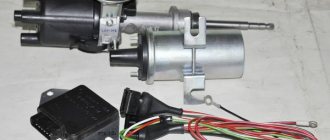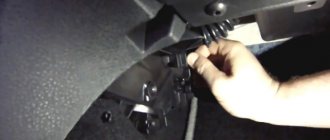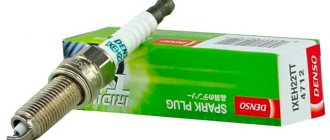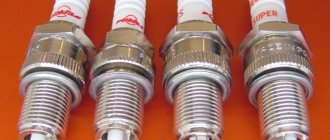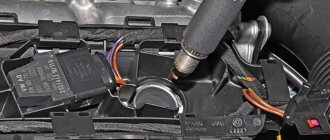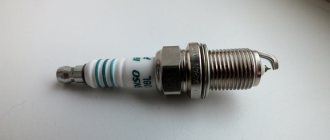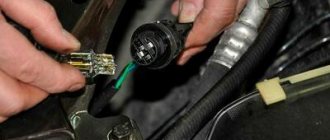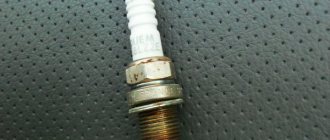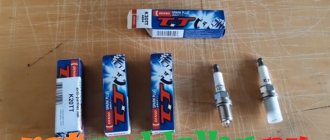Spark plugs for Lada Vesta 1.6 and 1.8 are needed to ignite the fuel and if one or more of them stop working, this will affect the stability of the car. Proper and maintenance is required. It is important to pay close attention to the operation of the engine and its ignition system. In most modern 1.6 and 1.8 engines, flammable mixtures are ignited using an electric charge. It passes between the copper or nickel electrodes of the spark plugs.
Worn igniters cause serious technical problems:
- significant reduction in engine power;
- excess fuel consumption;
- catalyst overheating;
- detonation (explosive nature of fuel combustion).
Replacing spark plugs on a Lada West on time helps the car's engine run longer and more efficiently. According to the technical recommendations of the AVTOVAZ company, replacing spark plugs in a Lada Vesta car should be done every 30,000 km. Car owners note that ignition devices do not fail so quickly. Given the difficult practical operating conditions of the car, it is better to adhere to the rule of frequent replacement.
We will indicate signs of wear on the ignition system elements and tell you how to replace the elements yourself.
Candles for the good news. what is installed from the factory
One of four engines can be installed on the Lada Vesta:
- the old eight-valve VAZ 11189 1.6 engine, which is currently not used on this model;
- 1.6-liter 16-valve engine VAZ 21129;
- 1.8-liter 16-valve VAZ 21179;
- French Renault/Nissan HR16de/Н4М engine, which is installed on Largus with a volume of 1.6 liters.
Based on this, the Lada Vesta could leave the assembly line with two types of spark plugs - for the old eight-valve engine and for the new 16-valve engine:
- Original VAZ spark plugs produced by the Standard plant from the city of Engels were used on the 8-valve VAZ 11189 engine and some 16-valve ones. Judging by the reviews of the owners, the spark plugs are so-so - the copper core of the central electrode did not contribute to a long service life, and they also did not work well at low temperatures. The brand of these candles is AU17DVRM. The maximum resource is no more than 12-15 thousand km.
- For all 16-valve engines that are installed on Vesta (VAZ 21129, 21179 and N4M), Brisk Super DR15YC-1 spark plugs made in the Czech Republic are used on the conveyor. At least that's what it says on the packaging and they work more stably.
- For the Renault H4M engine, LZKAR7D-NGK spark plugs were sometimes used.
Czech spark plugs BRISK'> Czech spark plugs BRISK
However, if you refuel at proven gas stations with good gasoline, then Czech spark plugs can withstand more than 30-40 thousand km.
Top 4. Bosch Super 4 FR78X
Rating (2020): 4.50
14 reviews from resources were taken into account: Reviewer
- Nomination
The most popular spark plugs Spark plugs do not overheat and ensure smooth engine operation at idle and no skipping when picking up speed. A balanced price and a real service life longer than stated determine the high popularity of the product on the market. - Characteristics Average price: 246 rub.
Maximum protection for the Lada Vesta engine (1.6 and 1.8 liters with 16 valves) can be provided by a set of Bosch Super 4 FR78X spark plugs. Thanks to the multi-electrode design, this model eliminates the risk of overheating and spontaneous combustion. A distinctive feature of the presented candles is their ability to self-clean from carbon deposits. Uniform wear of the electrodes and an effective thermoregulation system contribute to a significant increase in service life and extended replacement interval. The use of Super 4 FR78X spark plugs also allows you to increase the efficiency of the Vesta engine and ensure its reliable starting in difficult temperature conditions.
Advantages and disadvantages
- Wear resistance
- Four electrodes
- No spark lost
There are fakes
5 best spark plugs for Renault Logan
What you need to know about Lada Vesta spark plugs
A recent novelty of the domestic automobile industry - Lada Vesta - has become widespread among car enthusiasts.
Despite the fact that the car has been in production for only a few years, owners are gradually beginning to encounter minor problems and periodic maintenance, which includes replacing spark plugs on Lada Vesta cars.
This need is not a shortcoming of the machine or a serious breakdown; timely replacement of small spare parts will help in the future to avoid major repairs of the main moving parts.
Plugs are one of the most important components in the ignition system of any car; without them, it simply will not start. Using a discharge on the electrodes, the flammable fuel-air mixture is ignited. Engine power, efficiency and even toxicity of exhaust gases depend on the stable operation of igniters.
Lada Vesta cars produced from the factory can have two types of spark plugs:
- AU17DVRM (Russia);
- Brisk Super DR15YC-1 (Czech Republic).
Both of these models of ignition elements, according to reviews from car owners, have proven themselves well, they last well and do not cause problems.
It is usually recommended to replace the spark plugs after the vehicle has traveled a certain number of kilometers. It is not advisable to allow the wear of these elements to affect the operation of the engine and the entire ignition system.
But, if the igniters were not replaced in time, or the new ones turned out to be defective, then obvious signs of their malfunction will, first of all, affect the operation of the engine. The first sign is that the engine has become difficult to start and does not pull.
It may also trip or jerk and lose power. Sometimes wear of the ignition elements provokes increased gasoline consumption, as well as poor performance and overheating of the catalyst.
If traces of oil are found on the spark plugs themselves or the threads, this is a clear sign that the reflector caps also need to be replaced.
For a car, as for any other equipment, it is better to prevent the breakdown of any small spare parts with the help of timely maintenance than to experience difficulties with repairs in the future. Therefore, even when purchasing a completely new car, the owner is given a number of recommendations for operating the car and the necessary periodic maintenance.
AvtoVAZ, among other things, sets timing for replacing spark plugs for cars of the entire model range, including the new Lada Vesta. Plant specialists recommend changing them after every 30,000 kilometers.
In fact, the resource of their candles, and any others that will be installed, is approximately twice as long.
But due to bad gasoline and polluted air, it is possible that the igniters will fail the car owner at the most inopportune moment if they are not replaced within the specified period.
If the car's mileage has not yet reached 30,000 km, but problems with the ignition system have already appeared, it is necessary to check the installation of the spark plugs and measure the gap between them.
For a 16-valve Lada Vesta engine, the gap should be 1.1 mm, with the exception of the Renault-Nissan engine, where the gap is adjusted to 0.85-0.95 mm.
Sometimes, by adjusting this indicator, problems with the ignition system disappear.
Replacing ignition elements on a Lada Vesta is a simple process that any car enthusiast with little experience in car maintenance can handle. Replacement work must be carried out on a cooled engine. To do this, you need to have a Torx E-8 spark plug wrench and a high 16 socket with an extension, and to work with an 8-valve engine, it is enough to have a 21 wrench.
The procedure for replacing spark plugs on a Lada Vesta car on an 8-valve engine is simpler than on a 16-valve engine, since the installation location of the electrodes is on the surface of the cylinder block. Therefore, to replace them, it is enough to remove the wires, unscrew some of the replaced elements, and put new ones in their place. Then put the wires back in place.
In contrast, on a 16-valve engine, the spark plug holes are recessed into the block, so the plastic engine cover must first be removed. To do this, it is pulled sharply upward.
Then the harness is pulled out of the ignition coil, and the coil itself is unscrewed with a Torx E-8 wrench and removed from the spark plug well. Used spark plugs are unscrewed with a sixteen key, and new ones are installed and screwed in their place.
It is best to wrap them by hand in order to feel in a timely manner if the candle does not go along the thread of the spark plug hole.
Tighten the igniter with a torque of 25-30 Nm. Having completed the work, install all the dismantled parts in their places and connect the harness.
Lada Vesta has four engine options. One of them (the 1.6-liter VAZ-11189 8-valve engine) is no longer produced, but such cars are constantly seen on the roads. The remaining engines have 16 valves:
- VAZ-21129, 1.6 l;
- VAZ-21179, 1.8 l;
- Renault-Nissan HR16de/h4m, 1.6 l.
Depending on the type of engine, recommendations for selecting spark plugs for Lada Vesta may differ.
According to the recommendations of the AvtoVAZ plant, copper or nickel igniters made in Japan by Denso or NGK, as well as English or German spare parts, are suitable for installation on the entire Lada model range.
In addition to the manufacturer and the material from which they are made, spark plugs can also vary in design and have one, two or more electrodes.
For the 8-valve Lada Vesta engine, the installation of the following spare parts is recommended:
- RN9YC (Champion, England);
- W20EPR (Denso, Japan);
- BPR6ES-11 (NGK, Japan);
- A17DVRM (JSC Robert Bosch Saratov, Russia);
- WR7DCX (Bosch, Germany);
- 14R-7DU (Beru, Germany);
- LR15YC-1 (Brisk, Czech Republic).
16-valve engines VAS-21129 and VAZ-21179 operate on the following elements:
- FR7DCU (Bosch, Germany);
- Q20PR-U11 (Denso, Japan);
- BCPR6ES (NGK, Japan);
- AU17DVRM (JSC Robert Bosch Saratov, Russia);
- DR15YC-1 (Brisk, Czech Republic).
The 16-valve Renault-Nissan Hr16de/H4m operates on the following elements:
- nickel LZKAR7D-9 (NGK, Japan);
- platinum PLZKAR6A-11 (NGK, Japan).
Some car owners purchase replacement iridium spark plugs (for example, Denso IQ20).
Theoretically, such elements of the ignition system should provide lower fuel consumption, extend the life of the catalyst and ensure consistently good performance at both high and low speeds.
But, judging by the reviews of owners who tested different types of spark plugs, no significant difference in engine performance was noticed. The main thing is that they meet the requirements placed on them.
Spark plugs must be resistant to high temperatures arising in the combustion chamber (up to 1000°C), have resistance to thermal shock, be inert to substances formed during fuel combustion, operate reliably at a voltage of 40 kV, and their thermal conductivity must meet the standard.
You can purchase spark plugs at a regular auto parts store. The simplest copper parts are usually in stock, and you don’t have to wait for them to be ordered and delivered. If the chosen model is not available at the moment or there is no store nearby, then it will not be difficult to order candles of the chosen brand and manufacturer through the online store.
New Lada: Lada Largus roof rails in Balashikha
